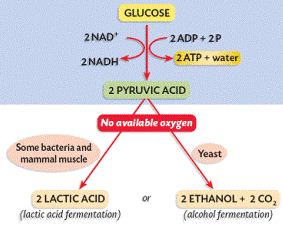Anaerobic Respiration does not require any O2. The respiration where O2 is essential called aerobic respiration The respiration that does not require O2 is called anaerobic respiration. Aerobic respiration occurs in all higher plants. Only a few lower plants (some Bacterial and Fungi) have anaerobic respiration. The processes are discussed below:-
It occurs in three steps, they are:
Step – 1: Glycolysis: In this step from one molecule of glucose there produces 2 molecules of Pyruvic Acid, 4 molecules of ATP (2 molecules utilised) and 2 molecules of NADH2.

Step – 2: In this step from each molecule of Pyruvic Acid there produces one molecule of Ethanol (Alcohol) and one molecule of CO2. Or from each molecule of Pyruvic Acid there produces only one molecule of Lactic Acid.
Step – 3: Krebs Cycle: Every molecule of Acetyle Co-A enter Krebs Cycle and after 10 successive reactions produces 2 molecules of COT, 3 molecules of FADH2, and I molecule of GTP (=ATP). From two molecules of Acetyle CO-A there produces 4 molecules of CO2, 6 molecules of NADH2, 2 molecules of FADH2, and 2 molecules of GTP (=ATP).














